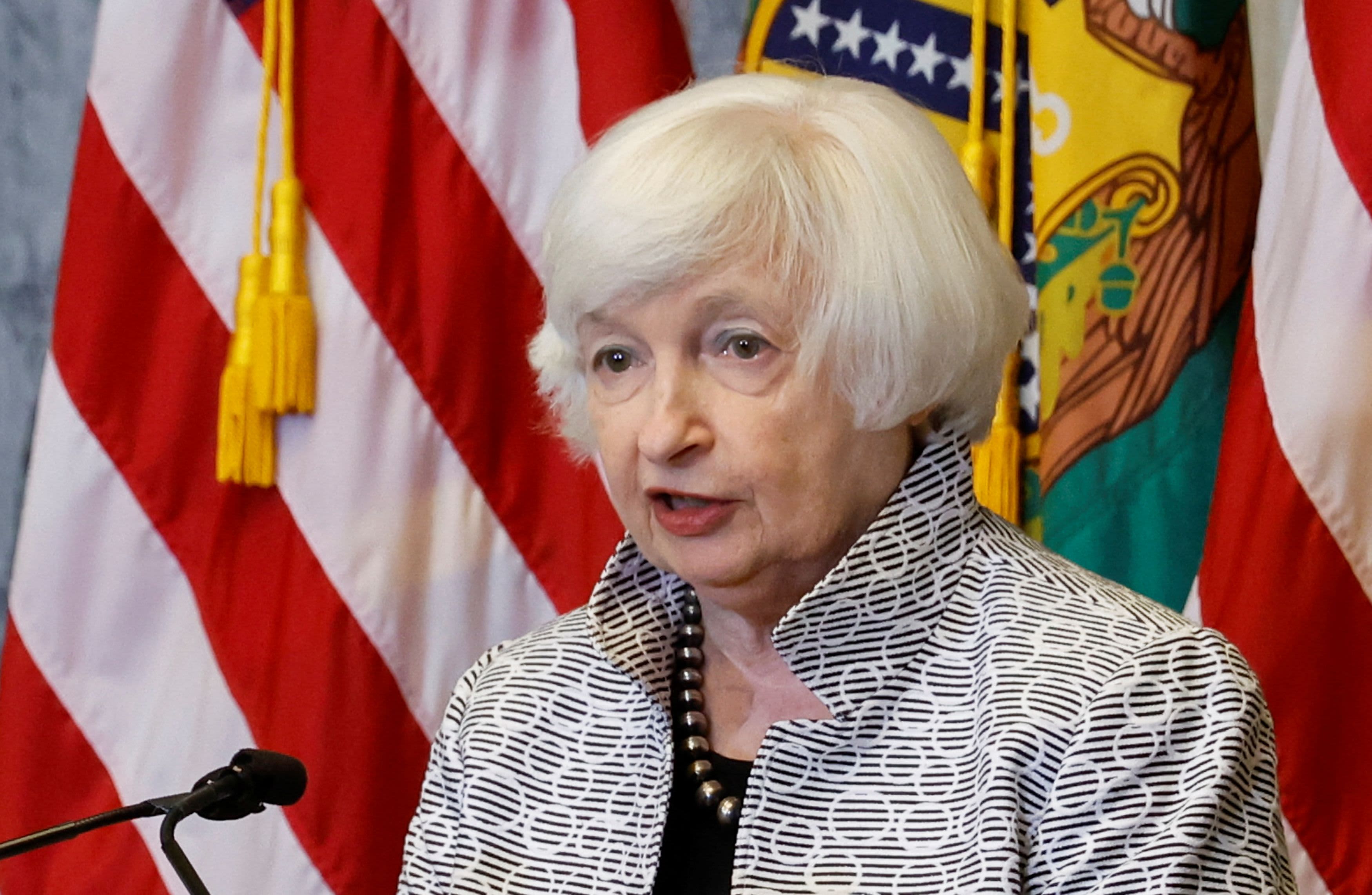The debt ceiling, sometimes referred to as the debt limit, is the total amount of money that the United States government is authorized to borrow to meet its existing legal obligations.
President-elect Donald Trump said Thursday that Congress should get rid of the debt ceiling, a day after he and Elon Musk came out against a deal reached by congressional lawmakers to fund the government before a shutdown occurs, NBC News reports.
Congress last raised the debt ceiling in June 2023, after the U.S. hit the ceiling on Jan. 18 of that year. The lengthy fight did not end in a default on the national debt, but instead that vote to raise and suspend the ceiling through Jan. 1, 2025.
Between that Jan. 1 debt ceiling reinstatement and the possibility of a government shutdown without a stopgap funding bill, the incoming Trump administration could face serious problems on day one.
In a phone call with NBC News on Thursday, against that backdrop, Trump suggested that the debt ceiling is a meaningless concept — and that no one knows for sure what would happen if it were to someday be breached — “a catastrophe, or meaningless” — and no one should want to find out.
“It doesn’t mean anything, except psychologically,” he said.
Here's a primer on the national debt, what happens if we default and why it's bad.
What is the national debt limit?
The national debt ceiling, or debt limit, is essentially a cap, decided by lawmakers, on how much debt the U.S. government can have.
On Jan. 18, 2023, the last time we reached that limit, it sat at a whopping $31.4 trillion dollars.
Because Congress voted in June to suspend the ceiling, when the debt limit is reinstated on Jan. 1, 2025, the new number will be based on the U.S.'s current debt at that time.
When Congress passes a spending bill, they decide what the government will spend its revenue on. That revenue comes mostly from taxes, but also from things like customs duties at the border and the sale of natural resources, according to the U.S. Treasury's Fiscal Data website.
Most of the time, the government doesn't have enough revenue on hand to pay for everything in those spending bills — such as infrastructure, social security, Medicare and defense. That's been the case since at least 2001, which was the last time the Treasury says more money was brought in than spent in a single year.
The gap between the revenue, and the things the government is spending it on, is the national deficit.
"We're spending more money, over a trillion dollars this year, than we're taking in," explained Greg Valliere, the Chief U.S. Policy Strategist for AGF Investments. "That gives us the deficit."
To make up the deficit and pay off debts, the Treasury sells securities, like bonds. The bond buyer gives the Treasury cash to pay the deficit, and in exchange the Treasury eventually pays the buyer back that money plus interest.
The debt limit caps how much debt the Treasury can take on to pay back the deficit incurred in previous years. As of Jan. 18, the Treasury took on the maximum $31.4 trillion in debt allowed — meaning we'd hit the debt limit.
The debt limit amount is decided by Congress.
"The debt limit is a political issue, that both parties have used to their advantage, that requires Congress to raise the amount of debt we can have," Valliere said.
What happens when we hit the debt limit?
Hitting the debt limit isn't catastrophic. According to U.S. Treasury Secretary Janet Yellen, the U.S. had already reached that ceiling as of Jan. 18. 2023.
"I don't think today's number means anything," Valliere said. "I think it's more of a summer crisis."
Hitting the debt limit is like starting the final countdown clock for the government before the real disaster — a default — strikes. Once the clock starts ticking, the U.S. needs to either increase the amount of debt it can take on, or suspend the limit to that debt before it runs out of money.
Yellen said in a May 2023 letter to Congress that the money could run out by June 1 of that year. Congress voted to suspend the debt limit just days before that deadline, on June 3.
"After reviewing recent federal tax receipts, our best estimate is that we will be unable to continue to satisfy all of the government's obligations by early June, and potentially as early as June 1, if Congress does not raise or suspend the debt limit before that time," the letter read in part, warning that an exact date is hard to estimate with "variable" conditions.
On May 26, Yellen once again revised her estimate based on the most recent available data, and set the deadline back to June 5.
All of the $31.4 trillion -- or more, when the limit is reinstated in January -- included under the current debt limit is money the government has already spent on things like infrastructure, defense and so forth.
Once the debt limit is reached, the Treasury can't sell any more bonds and other securities to pay off the debt from previous deficits. Put simply: it can't get cash to pay off bills the government has already accumulated.
If the U.S. can't pay those bills, then it defaults on the national debt. This is where catastrophe strikes.
Why is defaulting bad?
"[It's] in my opinion unthinkable to have the U.S. say 'We can't pay off our debt,'" Valliere said.
The Treasury would stop being able to pay out the federal money that goes to things like "Social Security and Medicare benefits, military salaries, interest on the national debt, tax refunds and other payments," according to a warning letter Yellen sent to Congress last week.
It would also stop the Treasury from paying back the money and interest that all those bond holders were promised when they made those purchases.
"I think it would be a signal to investors all around the world, including in the U.S... that the U.S. debt can't be counted on," Valliere said.
The U.S. credit rating "would almost certainly be downgraded," the White House said in a December 2021 post about the effects of a default, "and interest rates would broadly rise for many consumer loans, making products like auto loans and mortgages more expensive for families who are subject to interest rate changes or taking out new loans."
Higher interest rates due to downgraded U.S. credit would make it even harder for the Treasury to pay back the interest on future debt.
"In order to sell our debt, we're probably going to have to sell it at higher rates," Valliere said. "You'd have to offer higher rates to induce people to keep buying treasuries, because their risk will go up."
That would have a negative effect on the stock market. And with faith in the U.S. dollar tied to so many other pieces of the global market, those negative effects would be felt worldwide.
Why did we hit the debt limit last January?
Congress set the most recent $31.4 trillion debt limit back in December 2021, when Democratic majorities in both the House and the Senate voted to raise the debt limit by $2.5 trillion.
That vote came after another near-crisis after drawn out debate over spending, which ended just hours shy of the deadline set by Yellen.
"What's different this time I think is that you have an awful lot of very hardcore Republicans in the House, as we saw a couple of weeks ago," Valliere said last January, referring to the 15 votes that took place before former House Speaker Kevin McCarthy got the gavel.
"And they are unwilling to agree to any increase in the debt ceiling unless there's an ironclad pledge to reduce spending."
The reason the debate over raising the debt limit is so arduous is because there's no ideal place for the government to tighten its belt and close the deficit to reduce that debt, Valliere explained.
"The problem is, people agree generally that we're spending too much money and deficits aren't good," said Valliere. "But when you get specific and you say, alright, so what would you do? Would you cut social security? Well, no, my God. Would you cut Medicare? No. Would you cut defense? Well, not dramatically... Would you have a big tax increase? No."
Without tax increases to citizens or corporations, cuts or curtails to government spending or a combination of both, the national debt will continue to rise to a new limit set by Congress. Then this cycle repeats.
Does the debt limit stop U.S. government spending?
If the debt limit stayed where it was in January 2023, the U.S. would still have $31.4 trillion of debt to pay, because that money has already been spent and needs to be paid back.
The amount the government continues to spend on things it needs, like infrastructure, defense, and social security, is only determined by future spending deals. The continuing resolution that Congress is currently debating before the Dec. 20 shutdown deadline is one such future spending deal -- and it is a related, but different, political debate.
Theoretically, the debt limit is a tool to keep government spending from expanding unchecked.
If there's a ceiling on how much debt the U.S. Treasury can take on by issuing securities, then the government can't keep widening the deficit when it decides how much to spend.
But how to increase revenue — the amount of money the government is bringing in — is where Republicans and Democrats tend to disagree. Very generally, Republicans prefer to cut spending while Democrats find ways to raise more money through taxes.
Even when Congress authorizes an increase to the debt limit, the political negotiations required to get there can sometimes lead to some kind of budgeting compromise between the two very opposed parties.
According to Valliere in January, that logic still holds some weight.
"Previous deals have usually been accompanied by some fiscal restraint," he said. "As painful as this exercise will be, I think it almost certainly will [result] in less spending... Or, to be accurate in the phraseology, it's not like we're going to cut defense. We're going to slow the rate of increase."



